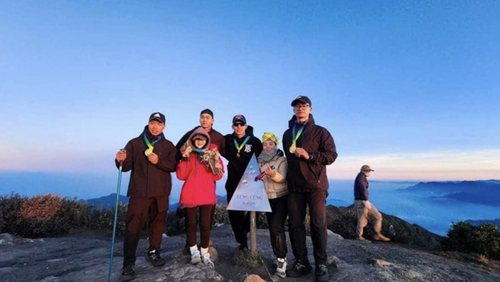Mu Cang Chai is home to nearly 83,000 hectares of forest, including almost 60,000 hectares of unspoiled natural woodland. Recognizing this potential, local authorities have embraced a holistic strategy that protects biodiversity while promoting tourism.
    |
 |
|
Tourists experience the Divine Rock tour in La Pan Tan commune, Mu Cang Chai district, Yen Bai province. |
For the ethnic H'mong community, the forest is a lifeline, said Giang A Long, Secretary of the Party cell of Che Tao village, Che Tao commune.
The village has encouraged people to contribute funds to support the forest patrol team. At the same time, communication campaigns have been launched to raise their awareness of forest protection and coordinate with the patrol team to regularly patrol the forest, he stated, adding that as a result, the deforestation has decreased substantially.
Che Tao commune alone spans over 23,000 hectares, with more than 20,000 under forest. Of this, around 18,000 hectares fall within the Mu Cang Chai species and habitat conservation area, home to a rich variety of flora and fauna, including rare ancient Po Mu (Fokienia hodginsii) and Thiet sam (Tsuga dumosa) trees. Nearly 100 households are entrusted with protecting these trees, which have become not only a symbol of environmental value but also a source of livelihood.
Each year, they receive nearly 10 billion VND (about 384,00 USD) in payments for forest environmental services.
“Thanks to the forest service payments, people now view the forest as a valuable livelihood and are more committed to protecting it,” said Giang A Hua, Vice Chairman of the communal People’s Committee. “As more tourists come to experience the untouched beauty of the forest, it provides new income streams and further motivation for conservation.”
Turning natural heritage into economic assets
Situated along the Hoang Lien Son mountain range, the conservation area is regarded as one of the most pristine primeval forests in northern Vietnam. It houses over 788 species of vascular plants and more than 3,000 naturally growing Po Mu trees, many of which are between 100 and 700 years old. Some reach heights of up to 30 meters and diameters exceeding 2 meters.
Local communities have begun mapping out trails and offering guided forest tours. “I’ve explored many forests in northern Vietnam, but none compare to this,” said Thao A Ky from Pung Luong commune. “At Ta Kay Dang, ancient and heritage-listed trees still flourish; it’s a paradise for nature enthusiasts.”
    |
 |
|
Tourists take part in a tour to conquer Lung Cung Peak in Nam Co commune, Mu Cang Chai district, and experience the local people's daily life. |
Inspired by the area’s beauty, Giang A De from La Pan Tan commune is developing new experiential tourism routes that connect forest trails with cultural sites, offering visitors a deeper connection with nature and the local way of life.
The district is positioning itself as a hub for eco-tourism, adventure travel, and wellness tourism. It blends breathtaking scenery with the unique cultural identity of the ethnic H'mong people to create authentic and sustainable travel experiences. Forest preservation remains central to the strategy, seen as vital for attracting tourists seeking unspoiled natural environments.
“Our vision is to turn natural heritage into economic assets that uplift local incomes,” said Giang A Cau, Secretary of the Mu Cang Chai district Party Committee. The district is diversifying its tourism offerings, from cultural immersion and visits to national heritage sites to trekking to peaks like Lung Cung and Ta Kay Dang, and exploring waterfalls such as Pu Nhu in La Pan Tan commune and the Seven-Storey Waterfall in Pung Luong commune.
These efforts are yielding results. Since the beginning of this year, Mu Cang Chai has welcomed 122,500 visitors, generating over 126 billion VND in revenue. In May alone, 34,500 tourists contributed nearly 33 billion VND to the local economy.
Source: VNA